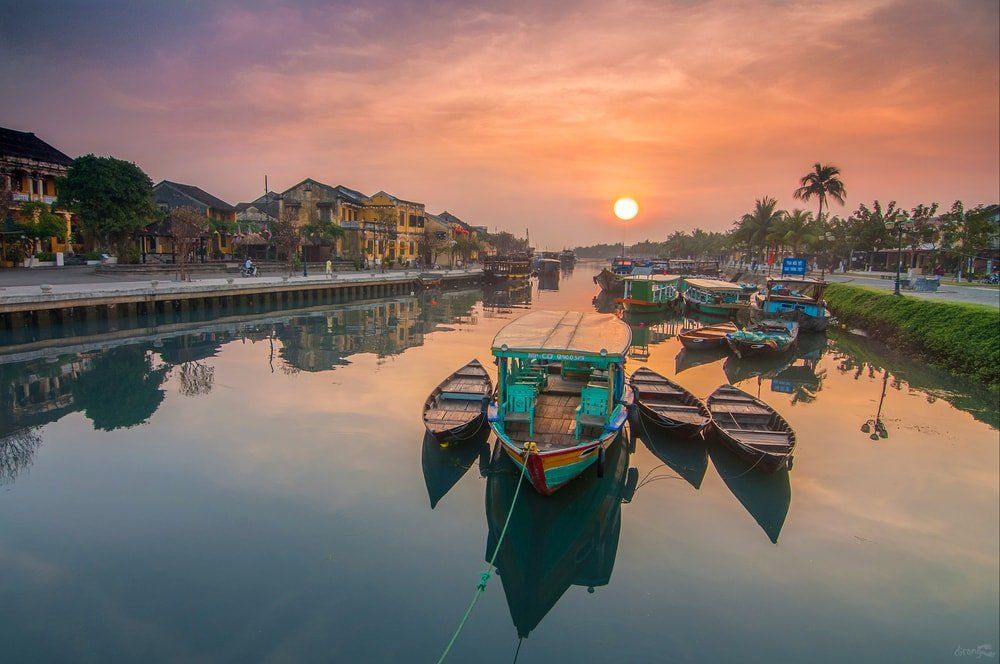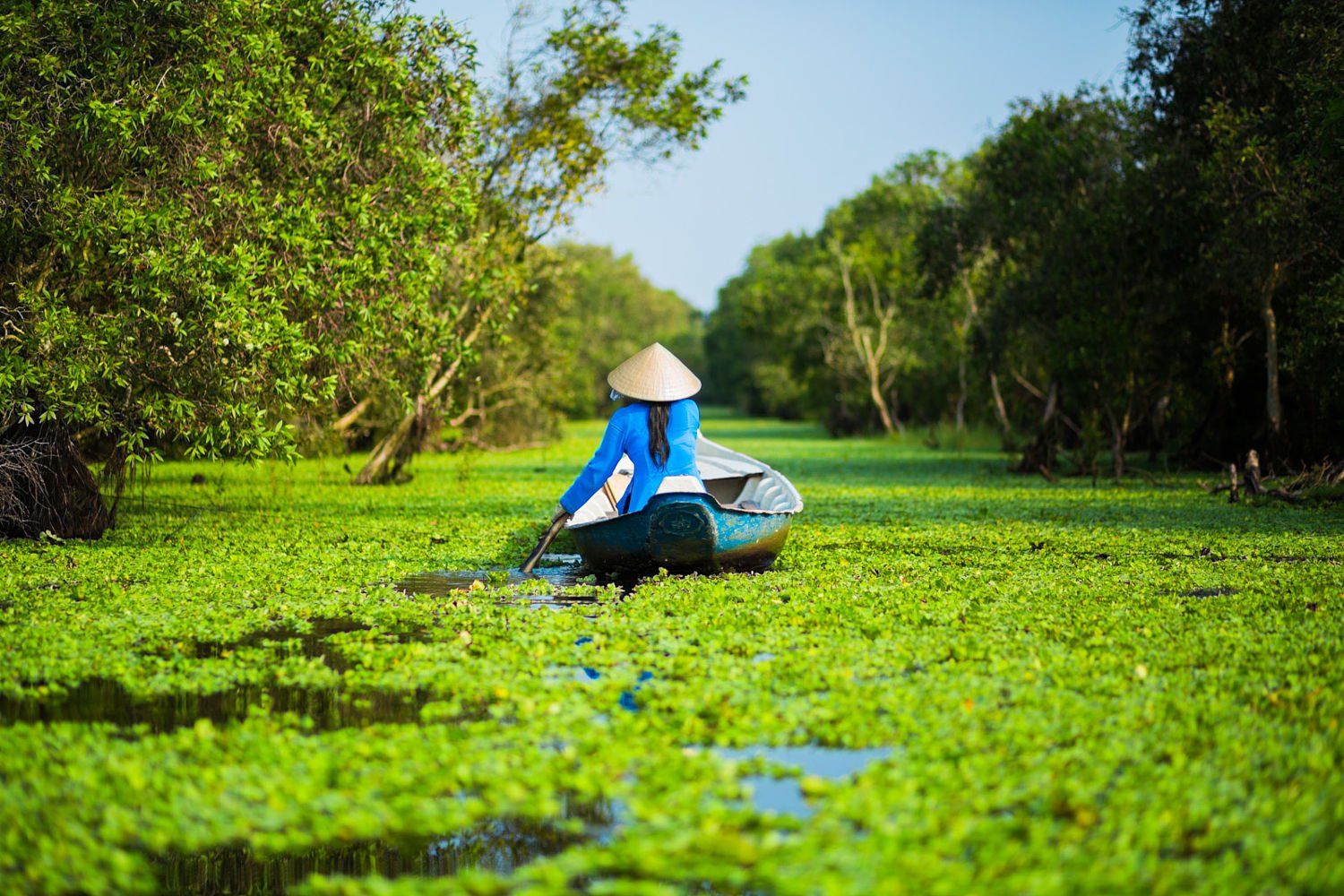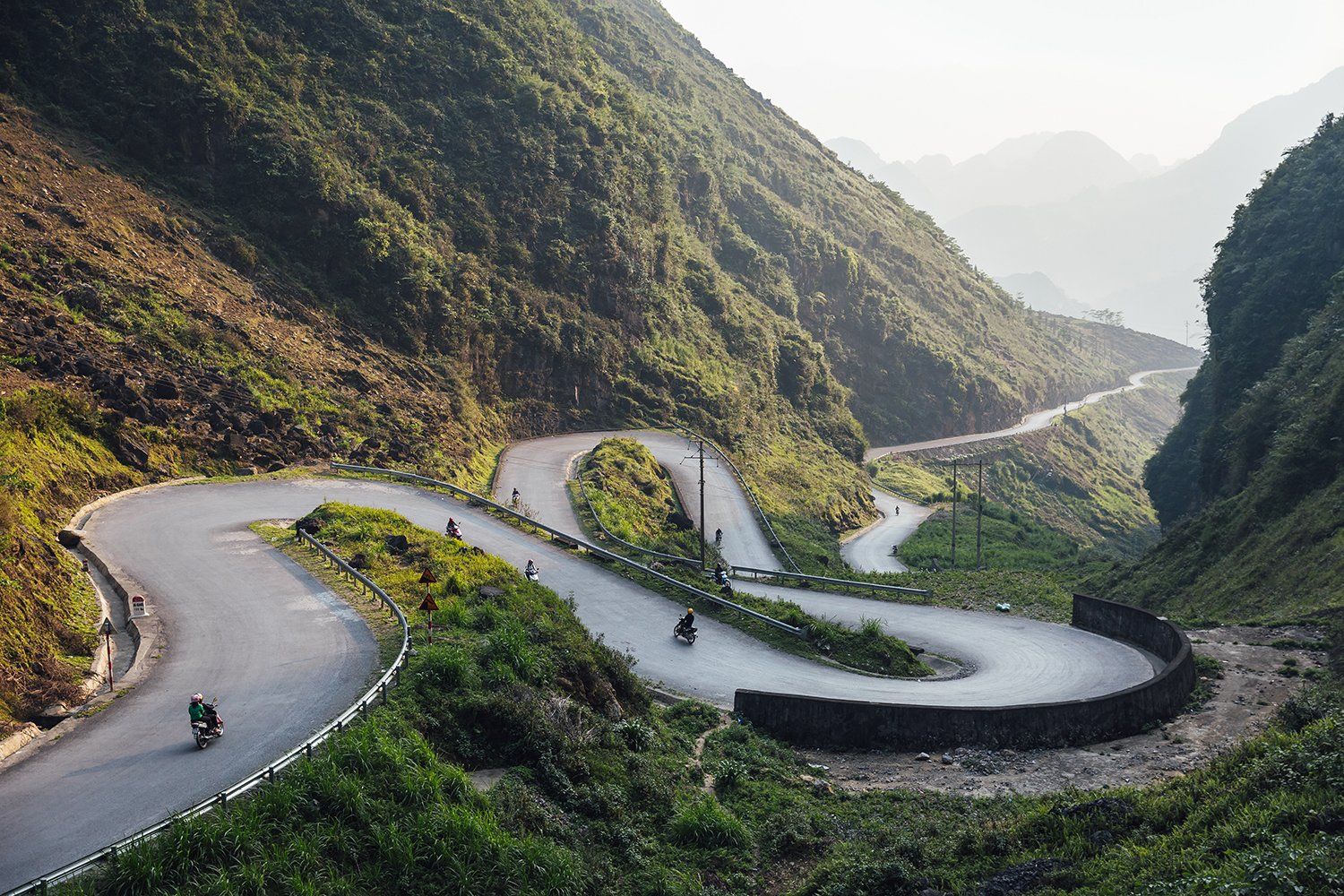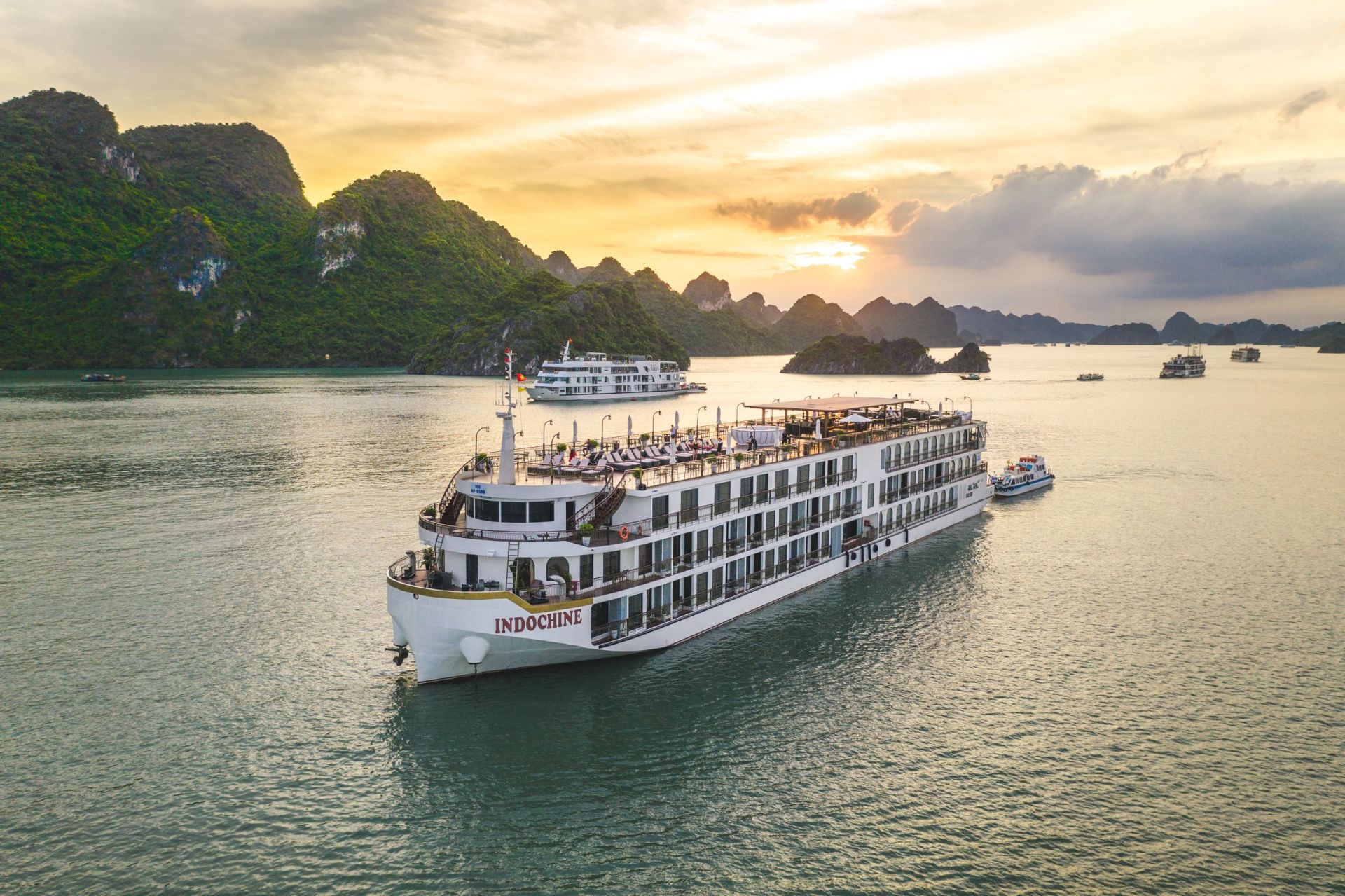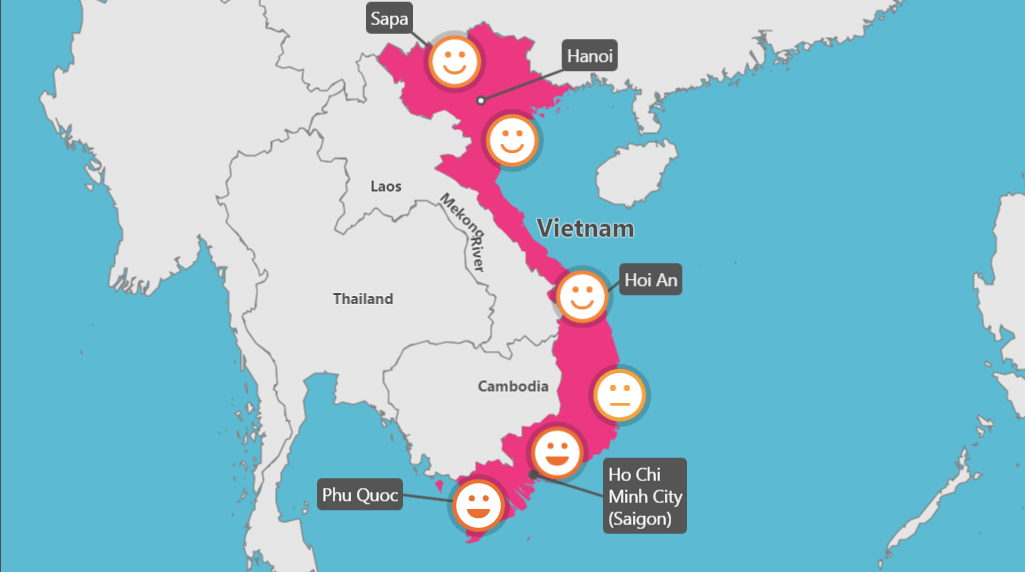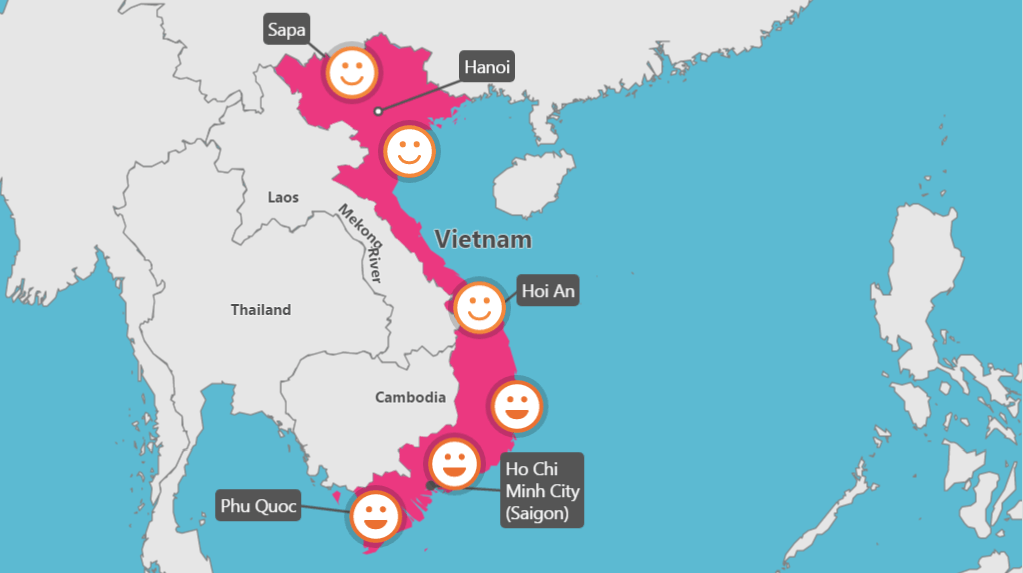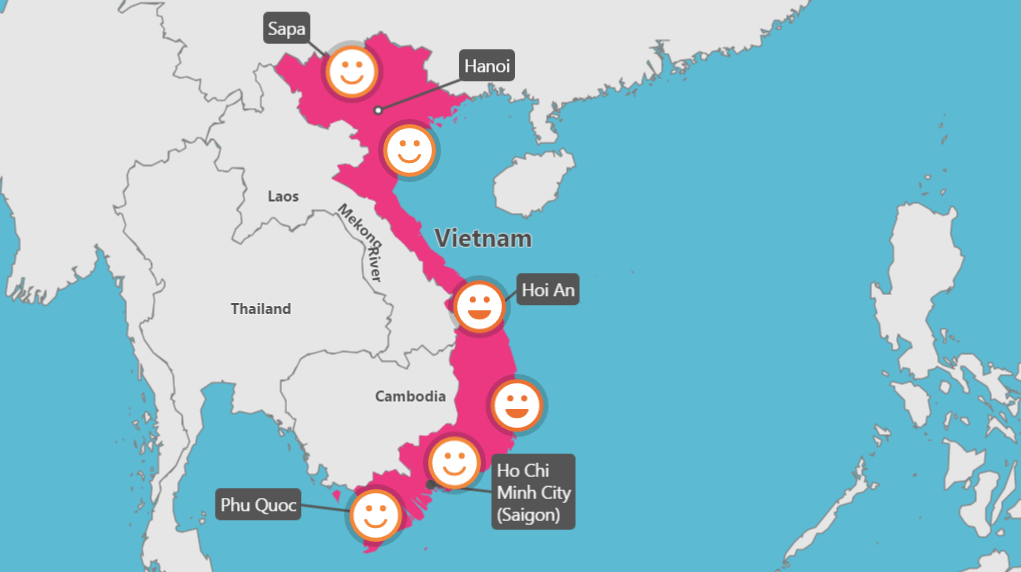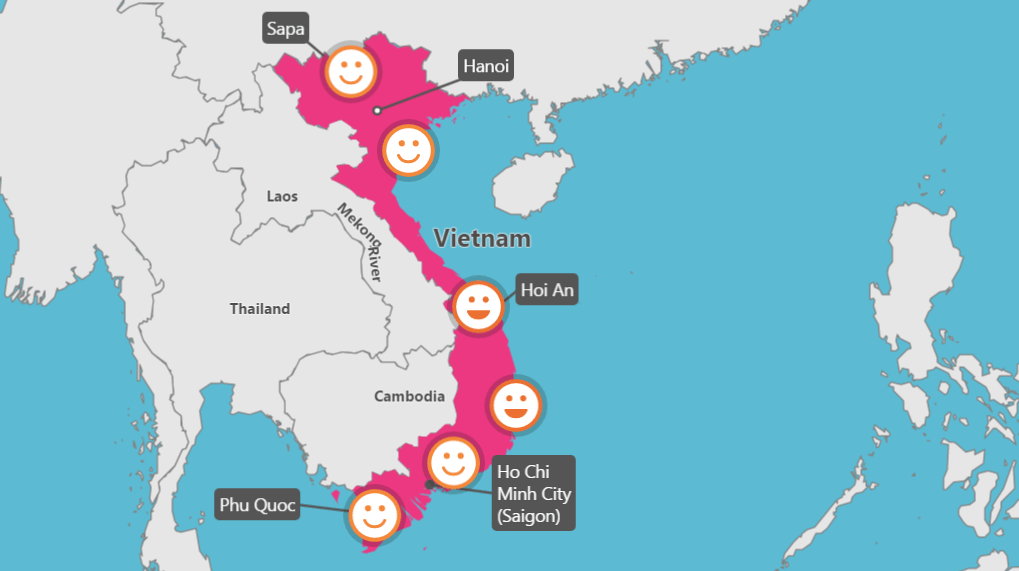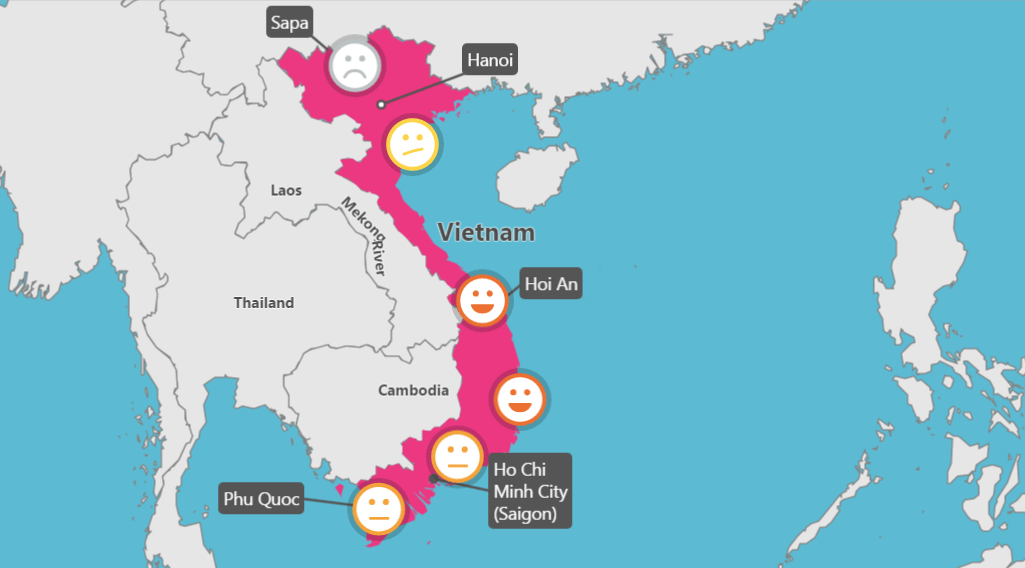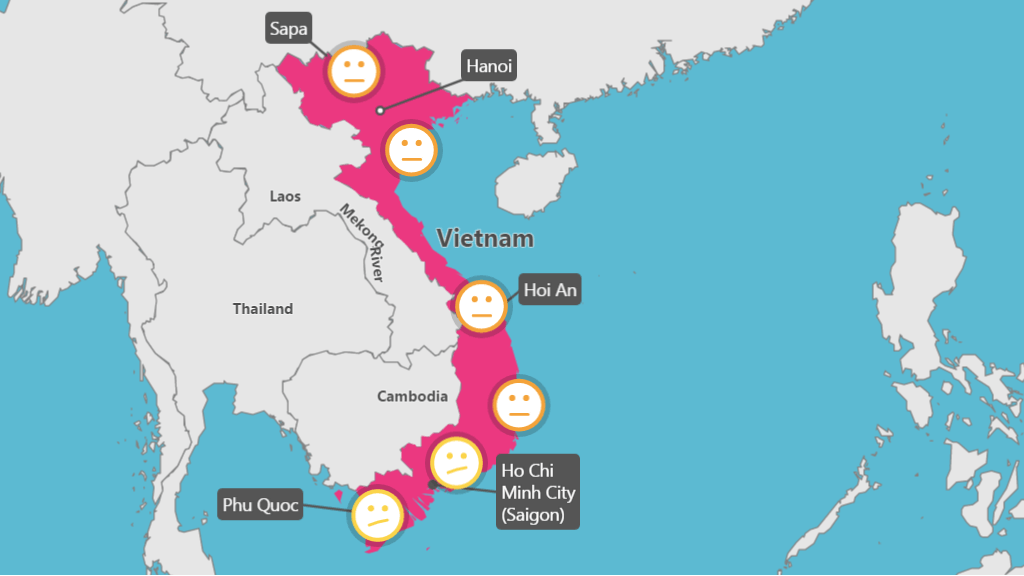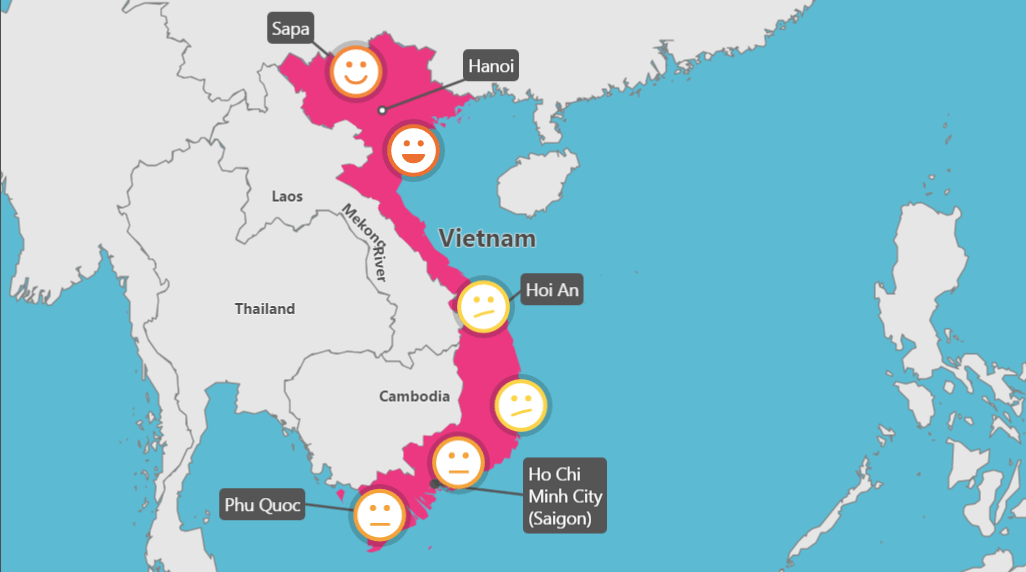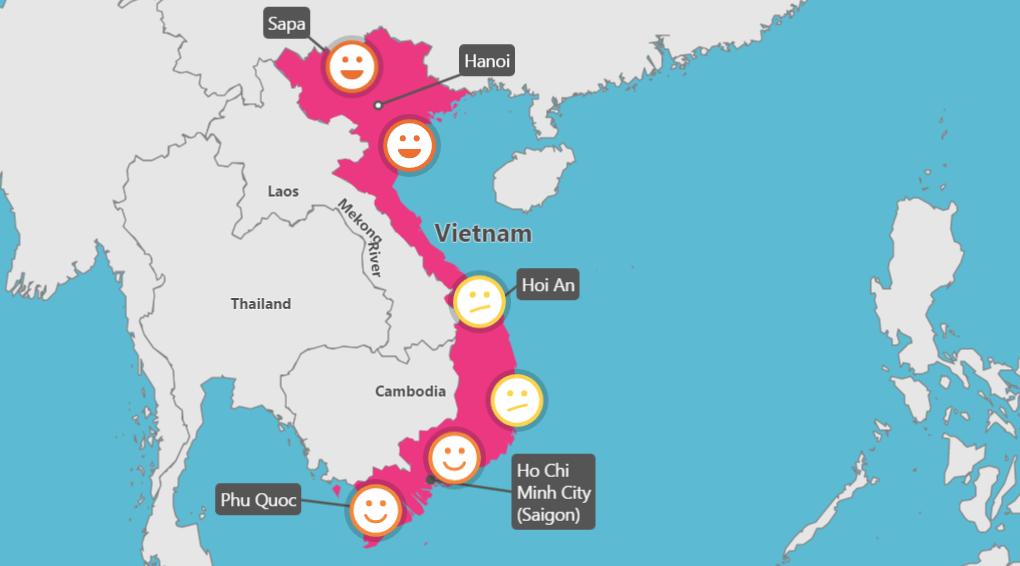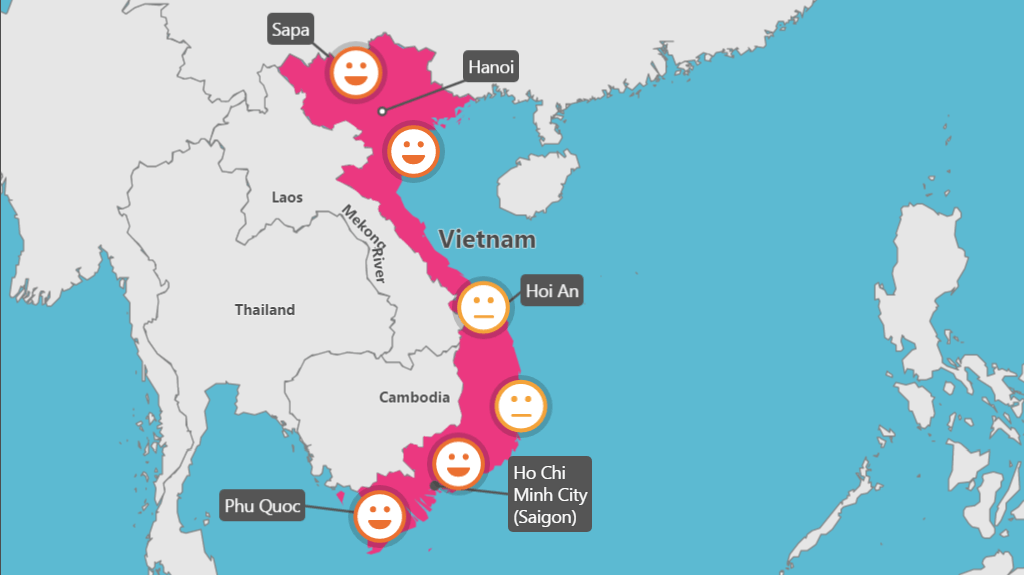Weather Vietnam
When is the best time to visit Vietnam?
WE'LL TAKE YOU WHERE YOU DREAM OF GOING IN VIETNAM
Travel packages, private tours, group tours
24/7 Support
Lowest Price Guarantee
Thousands of Reviews
When is the best time to visit Vietnam?
Deciding the best time to visit Vietnam greatly depends upon wishes from where to start or end your holiday in
Vietnam, as well as other factors might be considered such as holidays & festivals and not to forget how long you will stay because Vietnam is a amazing experience and even with rain your holiday can be a lot of fun! In general, the best time to visit Vietnam is hard to say it just depends on how your trip is organized and the time and season you are able to travel. In our experience & opinion you can travel whole year around if planned carefully on the end the weather is never to be controlled.
To understand the weather in Vietnam it will be the best way first to divide Vietnam by regions. Vietnam as a long shaped country in Asia has three regions (Northern, Central, and Southern) and all experience different types of seasons and weather conditions throughout the year. The south generally receives more rain with a tropical climate, however, Hanoi in the North and points farther up have cooler winters around December period than many travelers might expect. The area is one of the few places in Southeast Asia you can really feel cold without going to higher elevations.
In Hanoi & the north, May to October is hot and humid with high rainfall; November to April is cooler and dry. In the far north, December & January can be particularly cold. Central Vietnam experiences hot, dry weather between January & August when temperatures can hit the mid-30°C’s; whilst high levels of rainfall can occur in September, October & November. Southern Vietnam is generally dry and hot from November to April, and warm and wet between May & October, with the highest rainfall in June, July & August.
Planning a trip to Vietnam can be downright overwhelming. There are just so many places to visit (and things to eat!), that when you start to factor in the best time of year to visit Vietnam, it can make your head spin. We’ve know the feeling that's why we made the weather overview for Vietnam. But don’t worry, we’re going to go over exactly what to expect so you can plan your Vietnam trip based on your personal preferences, feel free to contact us, in this way we plan together.
North Vietnam
Hanoi, Halong Bay, Cuc Phuong, Mai Chau & Ninh Binh
Vietnam weather & when to go:
When is the best time to visit Vietnam?
Deciding the best time to visit Vietnam greatly depends upon wishes!
January
January overview
Vietnam returns to its best with dry conditions expected throughout much of the country. Both the north and south enjoy sunshine whilst the central region steps out of its wet season, meaning the beaches of Hoi An, Danang and Nha Trang are back on the menu (joining the in season Phu Quoc, Phan Thiet & Mui Ne). There is a variation in the temperature from one end of the country to the other with the south being close to its hottest and the north experiencing cooler weather.
Where's the sun and sand?
Hoi An, Danang, Quy Nhon, Nha Trang, Phan Thiet & Mui Ne, Con Dao & Phu Quoc, Tuy Hoa & Ho Tram
Our recommended journeys
Our Vietnam Travel Package takes you from city centre buzz through enthralling historic sites, to blissfully laid back beaches, giving a balanced taste of Vietnam’s cultural landscape.
Take in the headliner highlights and a handful of lesser-known gems, with the flexibility to tailor your time to suit you.
January's weather in detail
Northern Vietnam
Hanoi, Halong Bay, Lan Ha Bay, Sapa, Ha Giang, Ba Be Lake, Mu Cang Chai, Ninh Binh, Pu Luong & Mai Chau
January is one of the driest months of the year in Hanoi and the north. Whilst you can expect plenty of sunshine and clear blue skies, temperatures in the north will remain quite cool (avg temp: 18 °C). Rainfall is at its lowest in January although a misty haze is not unusual, especially in coastal areas and around Halong Bay. In the far north conditions are dry but chilly and sometimes foggy, especially at night, so suitable clothing is recommended.
Central Vietnam
Phong Nha, Hoi An, Danang, Hue, Nha Trang, Quy Nhon, Tuy Hoa, Dalat & Central Highlands
The weather in the centre of Vietnam is improving as the wet season draws to an end and prolonged rainfall becomes unlikely, especially during the 2nd half of the month (avg temp: 23°C). The change sees the beaches at Hoi An, Danang and Nha Trang shake off their winter coats and return to their glory days. Dalat and the Central Highlands are dry but chilly, especially at night so suitable clothing is recommended.
Southern Vietnam
Ho Chi Minh City, Phan Thiet & Mui Ne, Mekong Delta, Con Dao & Phu Quoc Island
It is all good news in the south with some of the best conditions of the year; blue skies and little, if any, rain expected across the region. The beaches within easy reach of Ho Chi Minh City - Phan Thiet & Mui Ne, Ho Tram & Long Hai - are basking in sunshine. As are the southern islands of Phu Quoc and Con Dao. Ho Chi Minh City remains a little cooler with low humidity (avg temp: 26°C).
Vietnam weather & when to go:
When is the best time to visit Vietnam?
Deciding the best time to visit Vietnam greatly depends upon wishes!
February
Where's the sun and sand?
Hoi An, Danang, Quy Nhon, Nha Trang, Phan Thiet & Mui Ne, Con Dao & Phu Quoc, Tuy Hoa & Ho Tram
Our recommended journeys
Our Vietnam Travel Package takes you from city centre buzz through enthralling historic sites, to blissfully laid back beaches, giving a balanced taste of Vietnam’s cultural landscape.
Take in the headliner highlights and a handful of lesser-known gems, with the flexibility to tailor your time to suit you.
February's weather in detail
Northern Vietnam
Hanoi, Halong Bay, Lan Ha Bay, Sapa, Ha Giang, Ba Be Lake, Mu Cang Chai, Ninh Binh, Pu Luong & Mai Chau
Whilst you can expect plenty of sunshine and clear blue skies, temperatures in the north will be quite cool (avg temp: 17 °C). Rainfall is at its lowest in February although a misty haze is not unusual, especially in coastal areas and around Halong Bay. In the far north conditions are dry but chilly and sometimes foggy, especially at night, so suitable clothing is recommended.
Central Vietnam
Phong Nha, Hoi An, Danang, Hue, Nha Trang, Quy Nhon, Tuy Hoa, Dalat & Central Highlands
Summer returns to central parts of Vietnam with the beaches of Hoi An and Danang likely to be basking in sunshine with just a light sprinkling of rain expected from time to time (avg temp: 25°C). Hue is also warm and dry whilst in Dalat and the Central Highlands the climate will be cooler due to altitude and warm clothing is recommended for the evenings, however conditions are good for trekking and adventure activities as experienced in Insider's. Further south the beaches of Nha Trang are also enjoying blue skies and higher temperatures.
Southern Vietnam
Ho Chi Minh City, Phan Thiet & Mui Ne, Mekong Delta, Con Dao & Phu Quoc Island
Good weather is expected in the south throughout February. The beaches of Phan Thiet & Mui Ne; Long Hai & Ho Tram, and the southern islands of Phu Quoc and Con Dao are experiencing clear blue skies, plenty of sunshine and little or no rain (avg temp: 27 °C). Temperatures remain high but comfortable with the really hot weather at the break of the wet season still a few months off (avg temp: 28°C).
February is a good month for diving around Con Dao, with clear waters and visibility averaging 20-30 metres.
Holidays
- Tet. Vietnamese New Year
- Celebrations usually last of up to six days when many Vietnamese will return to their ancestral homes. Expect some tourist sites, shops and markets as well as all government offices to be closed during the celebrations. In 2021 Tet will take place between the 12th - 17th February.
Vietnam weather & when to go:
When is the best time to visit Vietnam?
Deciding the best time to visit Vietnam greatly depends upon wishes!
March
March overview
Amongst the best months to travel in Vietnam; conditions are at their very best with dry, bright weather expected along the entire length of the country. The beaches of the south and central regions are enjoying hot weather with blue skies and plenty of sunshine whilst in the north it’s bright but much cooler. In both the mountains and highlands you can expect excellent trekking and adventure-activity conditions.
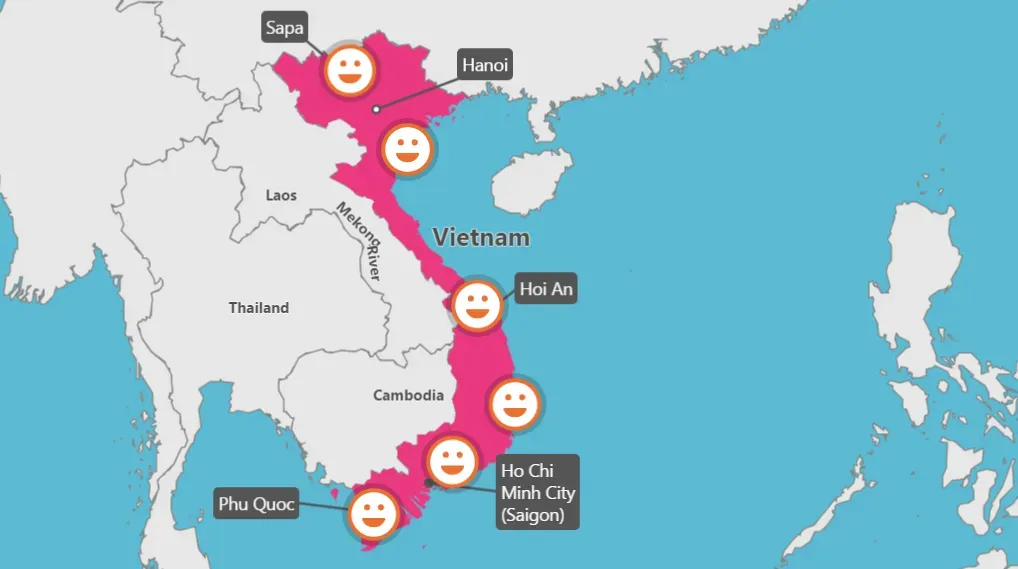
Where's the sun and sand?
Hoi An, Danang, Quy Nhon, Nha Trang, Phan Thiet & Mui Ne, Con Dao & Phu Quoc, Tuy Hoa & Ho Tram
Our recommended journeys
Our Vietnam Travel Package takes you from city centre buzz through enthralling historic sites, to blissfully laid back beaches, giving a balanced taste of Vietnam’s cultural landscape.
Take in the headliner highlights and a handful of lesser-known gems, with the flexibility to tailor your time to suit you.
March's weather in detail
Northern Vietnam
Hanoi, Halong Bay, Lan Ha Bay, Sapa, Ha Giang, Ba Be Lake, Mu Cang Chai, Ninh Binh, Pu Luong & Mai Chau
You can expect plenty of sunshine and clear blue skies, and whilst temperatures start to rise it remains cool with little if any rainfall (avg temp: 19 °C). Temperatures in the mountains are higher than earlier in the year with conditions for walking in Sapa, Mu Cang Chai and Ha Giang at their best.
Central Vietnam
Phong Nha, Hoi An, Danang, Hue, Nha Trang, Quy Nhon, Tuy Hoa, Dalat & Central Highlands
The beaches of Hoi An and Danang in central Vietnam are in full summer mode, basking in constant sunshine (avg temp: 28°C). Hue is also expected to be warm and dry and conditions in Dalat and the Central Highlands are excellent. Towards the south Nha Trang is also enjoying blue skies and higher temperatures.
Southern Vietnam
Ho Chi Minh City, Phan Thiet & Mui Ne, Mekong Delta, Con Dao & Phu Quoc Island
Temperatures in the south are starting to rise although the peak is not expected until later in the month or early April. The weather remains dry and the beaches within easy reach of Ho Chi Minh City - Phan Thiet & Mui Ne, Ho Tram & Long Hai - as well as the southern islands of Con Dao and Phu Quoc remain the best choices in the country (avg temp: 29 °C). Favourable diving conditions continue around the island of Con Dao in March, with visibility averaging 20-30 metres.
Vietnam weather & when to go:
When is the best time to visit Vietnam?
Deciding the best time to visit Vietnam greatly depends upon wishes!
April
April overview
April takes us towards the end of Vietnam’s very peak season from a weather perspective however this can come with the numerous advantages associated with lower visitor-numbers. Whilst the north is now heading towards its hot, wet summer you can still expect plenty of dry days. The beaches in the centre of the country are still at their very best and whilst rainfall starts to become more likely in the now very hot south; clear dry days are more prevalent.
Where's the sun and sand?
Hoi An, Danang, Quy Nhon, Nha Trang, Phan Thiet & Mui Ne, Con Dao & Phu Quoc, Tuy Hoa & Ho Tram
Our recommended journeys
Our Vietnam Travel Package takes you from city centre buzz through enthralling historic sites, to blissfully laid back beaches, giving a balanced taste of Vietnam’s cultural landscape.
Take in the headliner highlights and a handful of lesser-known gems, with the flexibility to tailor your time to suit you.
April's weather in detail
Northern Vietnam
Hanoi, Halong Bay, Lan Ha Bay, Sapa, Ha Giang, Ba Be Lake, Mu Cang Chai, Ninh Binh, Pu Luong & Mai Chau
The temperature in the north continues to rise as the region heads towards the hot, wet summer months. You can expect a few rainy days especially towards the end of the month (avg temp: 24°C). In the far northern mountains the conditions are excellent for walking and exploring the regions of Ha Giang, Mu Cang Chai and Sapa.
Central Vietnam
Phong Nha, Hoi An, Danang, Hue, Nha Trang, Quy Nhon, Tuy Hoa, Dalat & Central Highlands
What’s to say – it is sunshine and blue skies all the way for the centre of Vietnam with the beaches of Hoi An, Danang and Nha Trang at their best (avg temp: 28 °C). Further north Hue is also is also enjoying good weather, likewise to the west in the Central Highlands and in Dalat.
Southern Vietnam
Ho Chi Minh City, Phan Thiet & Mui Ne, Mekong Delta, Con Dao & Phu Quoc Island
It’s certainly hot in the south (avg temp: 31°C) and whilst the chances of rain are on the increase, clear skies are more likely throughout April ensuring that Phu Quoc, Con Dao, Phan Thiet & Mui Ne remain amongst the best of Vietnam’s beach choices.
Vietnam weather & when to go:
When is the best time to visit Vietnam?
Deciding the best time to visit Vietnam greatly depends upon wishes!
May
May overview
May remains amongst the better months to travel in Vietnam despite it being a slightly mixed bag in terms of weather. The central region is close to its peak whilst the south slowly begins to slip towards its wet season, especially towards the end of the month bring with it a welcome relief from the steamy heat of the past few months. The north is also starting to see more rain although temperatures are rising as it heads into its hot, sticky summer. In truth all the beaches remain good options although we tend to favor the beaches of Hoi An, Danang, Nha Trang and Phu Quoc.
Where's the sun and sand?
Hoi An, Danang, Quy Nhon, Nha Trang, Phan Thiet & Mui Ne, Con Dao & Phu Quoc, Tuy Hoa & Ho Tram
Our recommended journeys
Our Vietnam Travel Package takes you from city centre buzz through enthralling historic sites, to blissfully laid back beaches, giving a balanced taste of Vietnam’s cultural landscape.
Take in the headliner highlights and a handful of lesser-known gems, with the flexibility to tailor your time to suit you.
May's weather in detail
North Vietnam
Hanoi, Halong Bay, Lan Ha Bay, Sapa, Ha Giang, Ba Be Lake, Mu Cang Chai, Ninh Binh, Pu Luong & Mai Chau
Temperatures are rising in the north along with the chance of rain although dry days are still prevalent (avg temp: 29 °C). In the mountains conditions remain good with May being a good month to explore Mu Cang Chai and the Sapa region, whilst Ha Giang to the east starts to see more rain.
Central Vietnam
Phong Nha, Hoi An, Danang, Hue, Nha Trang, Quy Nhon, Tuy Hoa, Dalat & Central Highlands
What’s to say – it’s sunshine and blue skies all the way for the centre of Vietnam with the beaches of Hoi An, Danang and Nha Trang at their best (avg temp: 30 °C). Further north Hue is also is also enjoying good weather. To the west up in the Central Highlands and in Dalat rainfall is on the increase although far from its peak and you can still expect plenty of dry spells.
South Vietnam
Ho Chi Minh City,
Phan Thiet & Mui Ne,
Mekong Delta,
Con Dao &
Phu Quoc Island
Throughout the month the likelihood of rain will increase, although this helps to bring down the high temperatures of the past few months and you can still expect plenty of dry spells (avg temp: 28°C). Rain tends to fall in the afternoon often in short, heavy downpours. Despite the odd downpour, favorable diving conditions continue around the island of Con Dao in May.
Holidays
- Labour Day 1st May
Vietnam weather & when to go:
When is the best time to visit Vietnam?
Deciding the best time to visit Vietnam greatly depends upon wishes!
June
June overview
June is still a good month to travel in Vietnam despite it being a slightly mixed bag in terms of weather. The center of Vietnam has now hit peak temperatures and remains dry and bright. The south is now in the midst of the wet season with daily downpours to be expected, usually in the afternoon, whilst the north is well into summer mode with high temperatures and rain being the norm. Visitor numbers relatively low and the central beaches still promise a great deal of sunshine. Trekking is off the cards for most, with more rain spreading through the northern mountains & central highlands.
Where's the sun and sand?
Hoi An, Danang, Quy Nhon, Nha Trang, Phan Thiet & Mui Ne, Con Dao & Phu Quoc, Tuy Hoa & Ho Tram
Our recommended journeys
Our Vietnam Travel Package takes you from city centre buzz through enthralling historic sites, to blissfully laid back beaches, giving a balanced taste of Vietnam’s cultural landscape.
Take in the headliner highlights and a handful of lesser-known gems, with the flexibility to tailor your time to suit you.
June's weather in detail
Northern Vietnam
Hanoi, Halong Bay, Lan Ha Bay, Sapa, Ha Giang, Ba Be Lake, Mu Cang Chai, Ninh Binh, Pu Luong & Mai Chau
The north of the country is firmly in the middle of its summer by June meaning you can expect plenty of hot weather as well as rain and at times storms (avg temp: 30 °C). The mountains to the north are also very wet with extensive trekking unadvisable throughout the month.
Central Vietnam
Phong Nha, Hoi An, Danang, Hue, Nha Trang, Quy Nhon, Tuy Hoa, Dalat & Central Highlands
Dry, sunny days and blue skies continue for central Vietnam in June. The beaches of Hoi An, Danang and Nha Trang are at their best (avg temp: 30 °C); further north Hue is also enjoying good weather. In the Central Highlands and Dalat to the west, rainfall is still on the increase although travel is still possible.
Southern Vietnam
Ho Chi Minh City,
Phan Thiet & Mui Ne,
Mekong Delta,
Con Dao &
Phu Quoc Island
The south is now firmly into its wet season. However this is unlikely to be severe, and whilst the showers will be slightly heavier than in previous months you can still expect plenty of dry and bright daylight hours (avg temp: 28°C). June marks the start of Green Turtle nesting season on the beaches of Con Dao.
Vietnam weather & when to go:
When is the best time to visit Vietnam?
Deciding the best time to visit Vietnam greatly depends upon wishes!
July
July overview
July is a very similar story to June; a mixed bag in terms of weather. The center of Vietnam remains hot and predominantly dry with the odd light shower expected. The south is now in the midst of its wet season with daily downpours to be expected whilst the north is well into summer mode with high temperatures and rain the norm. Visitor numbers remain lower than earlier in the year and the central beaches still promise a great deal of sunshine. Trekking is not really off the cards for most regions for the one who like adventures however, with more rain in the northern mountains and central highlands.
Where's the sun and sand?
Hoi An, Danang, Quy Nhon, Nha Trang, Phan Thiet & Mui Ne, Con Dao & Phu Quoc, Tuy Hoa & Ho Tram
Our recommended journeys
Our Vietnam Travel Package takes you from city centre buzz through enthralling historic sites, to blissfully laid back beaches, giving a balanced taste of Vietnam’s cultural landscape.
Take in the headliner highlights and a handful of lesser-known gems, with the flexibility to tailor your time to suit you.
July's weather in detail
Northern Vietnam
Hanoi, Halong Bay, Lan Ha Bay, Sapa, Ha Giang, Ba Be Lake, Mu Cang Chai, Ninh Binh, Pu Luong & Mai Chau
The north of the country remains in summer meaning you can expect plenty of hot weather as well as rain and at times storms (avg temp: 30 °C). Halong Bay and Hanoi are prone to heavy showers at this time of year, infact July is one of the wettest months of the year in Hanoi. The mountains to the north are also very wet with trekking unadvisable throughout the month.
Central Vietnam
Phong Nha, Hoi An, Danang, Hue, Nha Trang, Quy Nhon, Tuy Hoa, Dalat & Central Highlands
The good news continues on the beaches of Hoi An, Danang and Nha Trang with plenty of sunshine and blue skies expected throughout the month. Temperatures remain high and whilst still predominantly dry, the odd shower is not out of place helping to temper the hot weather (avg temp: 31 °C). Hue is experiencing similar conditions but to the west Dalat and the Central Highlands high rainfall makes extensive trekking and adventure activities unadvisable.
South Vietnam
Ho Chi Minh City, Phan Thiet & Mui Ne, Mekong Delta, Con Dao & Phu Quoc Island
The south is now firmly into its wet season. However this is unlikely to be severe and whilst the showers will be slightly heavier than in previous months you can still expect plenty of dry and bright daylight hours (avg temp: 29°C). If you're planning to dive around the island of Con Dao, favorable water conditions can still be enjoyed in July, although realistically it is the last month of the dive season.
Vietnam weather & when to go:
When is the best time to visit Vietnam?
Deciding the best time to visit Vietnam greatly depends upon wishes!
August
August overview
The overall outlook is very mixed in terms of weather. The centre of Vietnam remains hot and predominantly dry with infrequent rain expected, but increasing towards the end of the month. The south is firmly in the midst of the wet season with daily downpours to be expected whilst the north is well into summer mode with high temperatures and frequent rain the norm. Visitor numbers relatively remain low and the central beaches still promise a great deal of sunshine. Most regions in the northern mountains and central highlands have rain fall.
Where's the sun and sand?
Hoi An, Danang, Quy Nhon, Nha Trang, Phan Thiet & Mui Ne, Con Dao & Phu Quoc, Tuy Hoa & Ho Tram
Our recommended journeys
Our Vietnam Travel Package takes you from city centre buzz through enthralling historic sites, to blissfully laid back beaches, giving a balanced taste of Vietnam’s cultural landscape.
Take in the headliner highlights and a handful of lesser-known gems, with the flexibility to tailor your time to suit you.
August 's weather in detail
Northern Vietnam
Hanoi, Halong Bay, Lan Ha Bay, Sapa, Ha Giang, Ba Be Lake, Mu Cang Chai, Ninh Binh, Pu Luong & Mai Chau
The north of the country remains in summer meaning you can expect plenty of hot weather as well as rain and at times storms (avg temp: 30 °C). Halong Bay and Hanoi are prone to heavy showers at this time of year, infact August is one of the wettest months of the year in Hanoi. The mountains to the north are also very wet with trekking unadvisable throughout the month.
Central Vietnam
Phong Nha, Hoi An, Danang, Hue, Nha Trang, Quy Nhon, Tuy Hoa, Dalat & Central Highlands
The beaches of Hoi An and Danang are still the pick of the bunch with good weather expected throughout the month. Temperatures remain high and whilst still predominantly dry, rain is expected more frequently towards the end of the month (avg temp: 30 °C). Nha Trang is likely to see the best of the weather, although towards the end of the month it can become overcast at times. Hue is experiencing higher rainfall whilst to the west the Central Highlands are now very wet making adventure activities unadvisable.
Southern Vietnam
Ho Chi Minh City, Phan Thiet & Mui Ne, Mekong Delta, Con Dao & Phu Quoc Island
The south is now firmly into its wet season, thankfully however this is unlikely to be severe; whilst the showers will be slightly heavier than in previous months you can still expect plenty of dry and bright daylight hours (avg temp: 29°C). From mid-August, Green Turtle hatchlings can be observed emerging from the beaches on Con Dao and making their first steps to the sea.
Vietnam weather & when to go:
When is the best time to visit Vietnam?
Deciding the best time to visit Vietnam greatly depends upon wishes!
September
September overview
Wet weather is on the increase in central regions where, towards the end of the month in particular, rain is expected to become more frequent. Conditions in the north are moving in the opposite direction with less rainfall expected, especially as we head towards October. In the mountains of Sapa things are also improving with trekking very much an option once again. Things remain largely unchanged in the south although rainfall does start to decrease as we move into October.
Where's the sun and sand?
Hoi An, Danang, Quy Nhon, Nha Trang, Phan Thiet & Mui Ne, Con Dao & Phu Quoc, Tuy Hoa & Ho Tram
Our recommended journeys
Our Vietnam Travel Package takes you from city centre buzz through enthralling historic sites, to blissfully laid back beaches, giving a balanced taste of Vietnam’s cultural landscape.
Take in the headliner highlights and a handful of lesser-known gems, with the flexibility to tailor your time to suit you.
September's weather in detail
Northern Vietnam
Hanoi, Halong Bay, Lan Ha Bay, Sapa, Ha Giang, Ba Be Lake, Mu Cang Chai, Ninh Binh, Pu Luong & Mai Chau
North Vietnam is edging towards the end of its summer although you can still expect plenty of hot weather as well as some rain (avg temp: 28 °C). Towards the end of the month in particular the temperature starts to drop a little and the rainfall becomes less frequent. In the far north the weather in Sapa is starting to improve making trekking an option once again. Late September is a particularly picturesque time of year to visit Mu Cang Chai, as the region's endless rice fields turn a golden colour, ready to harvest.
Central Vietnam
Phong Nha, Hoi An, Danang, Hue, Nha Trang, Quy Nhon, Tuy Hoa, Dalat & Central Highlands
The weather in the centre of the country is ready for a change come September and throughout the month rain is on the increase in Hoi An and Hue. Temperatures drop a little and stormy weather is a possibility especially towards the end of the month (avg temp: 28°C). Further south it’s a similar picture as the beaches of Nha Trang start to see an increase in rain. Dalat and the Central Highlands are now very wet making trekking and adventure activities unadvisable, and some of the Phong Nha caves may be off limits due to flooding.
Southern Vietnam
Ho Chi Minh City, Phan Thiet & Mui Ne, Mekong Delta, Con Dao & Phu Quoc Island
The south remains wet although rainfall is decreasing as the month progresses. Temperatures remain high and whilst frequent rain is to be expected you can also still expect plenty of dry and bright daylight hours (avg temp: 28°C).
Holidays
- National Day 2nd September
- Ghost Festival (Xa Toi Vong Nhan) Also known as the Hungry Ghost Festival, in which living descendants pay homage to their deceased ancestors, and during this time the deceased are believed to visit the living.
Vietnam weather & when to go:
When is the best time to visit Vietnam?
Deciding the best time to visit Vietnam greatly depends upon wishes!
October
October overview
Things continue to improve in the north with clearer skies, less rainfall and a break to the high humidity of recent months. In the centre it’s the opposite story with high rainfall and the chance of stormy weather. Whilst the rain tumbles in the centre, the south starts to see a change for the good with less rainfall and a promise of the returning summer. Good conditions for adventure activities also return in the mountains of the north and in the Central Highlands.
Where's the sun and sand?
Hoi An, Danang, Quy Nhon, Nha Trang, Phan Thiet & Mui Ne, Con Dao & Phu Quoc, Tuy Hoa & Ho Tram
Our recommended journeys
Our Vietnam Travel Package takes you from city centre buzz through enthralling historic sites, to blissfully laid back beaches, giving a balanced taste of Vietnam’s cultural landscape.
Take in the headliner highlights and a handful of lesser-known gems, with the flexibility to tailor your time to suit you.
October's weather in detail
Northern Vietnam
Hanoi, Halong Bay, Lan Ha Bay, Sapa, Ha Giang, Ba Be Lake, Mu Cang Chai, Ninh Binh, Pu Luong & Mai Chau
October sees the end of the wet season in the north, and as the month moves on the temperature drops, as does the rainfall, especially in the second half of the month as the cooler, dry winter approaches (avg temp: 26°C). In the far north, the weather in the mountainous regions of Sapa and Ha Giang is dry and clear, promising some of the best trekking conditions of the year. Early October is a particularly picturesque time of year to visit Mu Cang Chai, as the region's endless rice fields turn a golden colour, ready to harvest.
Central Vietnam
Phong Nha, Hoi An, Danang, Hue, Nha Trang, Quy Nhon, Tuy Hoa, Dalat & Central Highlands
The rainfall in the centre of the country is close to its peak and heavy storms can occur. Hoi Ai in particular is prone to flooding in October. The temperatures in Hoi An and Hue differ slightly with Hoi An and Danang being the hotter end of the Hai Van Pass (avg temp: 24- 27°C). Further to the south the beaches of Nha Trang will be seeing plenty of rain with nearly half the city's annual rainfall falling in October and November. The heavy rains in Dalat and the Central Highlands start to break, especially towards the end of the month when good conditions for outdoor activity return. However, weeks of heavy rainfall could mean that some of the Phong Nha caves are inaccessible and not possible to visit.
Southern Vietnam
Ho Chi Minh City, Phan Thiet & Mui Ne, Mekong Delta, Con Dao & Phu Quoc Island
October is the month for change in the south with rainfall on the decline especially towards the end of the month as the region moves towards its dry, hot summer months (avg temp: 27 °C). The southern beaches of Phan Thiet & Mui Ne, and the islands of Phu Quoc & Con Dao are starting to recover from the winter months and the sun starts to shine once again, especially towards the end of the month. Around the island of Con Dao, Green Turtle hatchlings continue to emerge from their nesting grounds under the sand and make their first steps to the sea.
Vietnam weather & when to go:
When is the best time to visit Vietnam?
Deciding the best time to visit Vietnam greatly depends upon wishes!
November
November overview
The dry, cooler weather has firmly returned to north Vietnam making November one of the best months to visit. The central regions are receiving the lion’s share of the rain with stormy weather a possibility at times. In the far south it’s a different story with blue skies and sunshine ensuring that the beaches of Phu Quoc, Phan Thiet & Mui Ne are back to their best, a situation that will remain for the coming six months. Good conditions for adventure activities continue in the mountains of the north and also return to the Central Highlands.
Where's the sun and sand?
Hoi An, Danang, Quy Nhon, Nha Trang, Phan Thiet & Mui Ne, Con Dao & Phu Quoc, Tuy Hoa & Ho Tram
Our recommended journeys
Our Vietnam Travel Package takes you from city centre buzz through enthralling historic sites, to blissfully laid back beaches, giving a balanced taste of Vietnam’s cultural landscape.
Take in the headliner highlights and a handful of lesser-known gems, with the flexibility to tailor your time to suit you.
November's weather in detail
Northern Vietnam
Hanoi, Halong Bay, Lan Ha Bay, Sapa, Ha Giang, Ba Be Lake, Mu Cang Chai, Ninh Binh, Pu Luong & Mai Chau
By November the hot and wet summer is becoming a distant memory in the north and the region is now enjoying some of the best conditions of the year. Temperatures remain moderate and the little rain there is becomes infrequent and light (avg temp: 24°C).
In the far north the weather in the mountainous regions of Mu Cang Chai, Sapa and Ha Giang is dry and clear promising some of the best trekking conditions of the year. November is also considered to be one of the best months to experience a junk cruise on Halong Bay.
Central Vietnam
Phong Nha, Hoi An, Danang, Hue, Nha Trang, Quy Nhon, Tuy Hoa, Dalat & Central Highlands
The rainfall in the centre of the country is at its peak and heavy storms can occur. Hoi Ai in particular is prone to flooding in November. The temperatures in Hoi An and Hue differ with Hoi An and Danang being the hotter end of the Hai Van Pass (avg temp: 23- 25°C). Further south Nha Trang (sitting in its own micro-weather system) will be seeing plenty of rain with nearly half the city's annual rainfall falling in October and November. Up in the Central Highlands and Dalat it’s a different story with clear skies and little if any rain expected.
Southern Vietnam
Ho Chi Minh City, Phan Thiet & Mui Ne, Mekong Delta, Con Dao & Phu Quoc Island
Come November the south welcomes back the summer in all its glory with some of the best weather of the year, thanks to clear skies and a drop in humidity (avg temp: 27°C). The beaches within easy reach of Ho Chi Minh City - Phan Thiet & Mui Ne, Ho Tram & Long Hai - are experiencing blue skies and plenty of sunshine. The islands of Phu Quoc and Con Dao are also enjoying warm, dry weather, making the southern beaches the pick of the bunch in November.
Vietnam weather & when to go:
When is the best time to visit Vietnam?
Deciding the best time to visit Vietnam greatly depends upon wishes!
December
December overview
It continues to be good news for much Vietnam with optimum conditions in both the north and south, as well as an improving situation in central regions as the rains start to decrease. The pick of the beaches remain Phu Quoc, Phan Thiet & Mui Ne, and towards the end of the month Nha Trang becomes a good option again. In the mountains and highlands good conditions continue although temperatures are low, especially at night.
Where's the sun and sand?
Hoi An, Danang, Quy Nhon, Nha Trang, Phan Thiet & Mui Ne, Con Dao & Phu Quoc, Tuy Hoa & Ho Tram
Our recommended journeys
Our Vietnam Travel Package takes you from city centre buzz through enthralling historic sites, to blissfully laid back beaches, giving a balanced taste of Vietnam’s cultural landscape.
Take in the headliner highlights and a handful of lesser-known gems, with the flexibility to tailor your time to suit you.
December's weather in detail
Northern Vietnam
Hanoi, Halong Bay, Lan Ha Bay, Sapa, Ha Giang, Ba Be Lake, Mu Cang Chai, Ninh Binh, Pu Luong & Mai Chau
The good news continues in the north with little rain expected and moderate temperatures throughout the region (avg temp: 19°C). Infact, December is one of the driest months of the year in Hanoi and the north. In the far northern mountains of Mu Cang Chai, Sapa and Ha Giang the conditions remain excellent with dry, clear days however it can be cold, especially in the evenings, so suitable clothing is recommended.
Central Vietnam
Phong Nha, Hoi An, Danang, Hue, Nha Trang, Quy Nhon, Tuy Hoa, Dalat & Central Highlands
Whilst conditions undoubtedly start to improve in central regions with a significant drop in rainfall, stormy weather is still a possibility especially early in December. More rainfall is expected in Hue than in Hoi An whilst throughout the region temperatures are close to their lowest for the year, although still far from chilly (avg temp: 24°C). Towards the south, Nha Trang will be seeing rainfall, although this steadily declines through the month. In Dalat conditions remain excellent with dry, clear days however it can be cold, especially in the evenings.
Southern Vietnam
Ho Chi Minh City, Phan Thiet & Mui Ne, Mekong Delta, Con Dao & Phu Quoc Island
It’s all good news in the south with some of the best conditions of the year: blue skies and little, if any, rain can be expected across the region in December. The beaches within easy reach of Ho Chi Minh City - Phan Thiet & Mui Ne, Ho Tram & Long Hai - are basking in sunshine. The southern islands of Phu Quoc and Con Dao are also enjoying sunny days and warm weather, whilst Ho Chi Minh City remains a little cooler with low humidity (avg temp: 26°C).If you're considering a Christmas holiday in Vietnam, head to the south.
Holidays
- Christmas Day
- Once very much a 'foreigners festival', Christmas Day is starting to feature more in Vietnamese society.
Dreaming of your very own adventure in Vietnam?
We love to talk about travel & sharing more information
Send us your travel requirements for local expert advice and carefully crafted itineraries.


